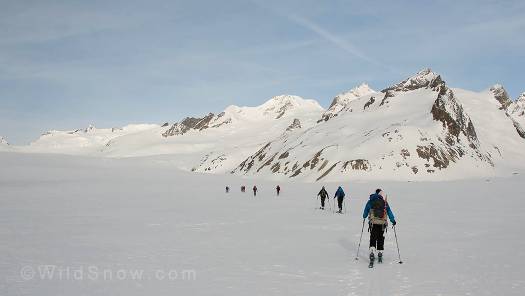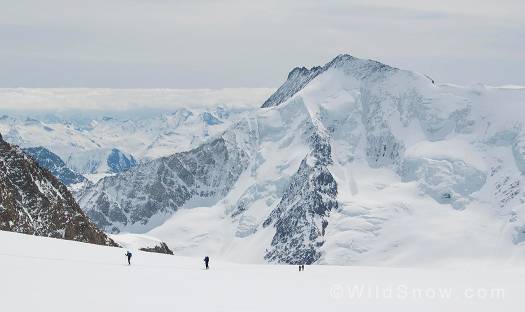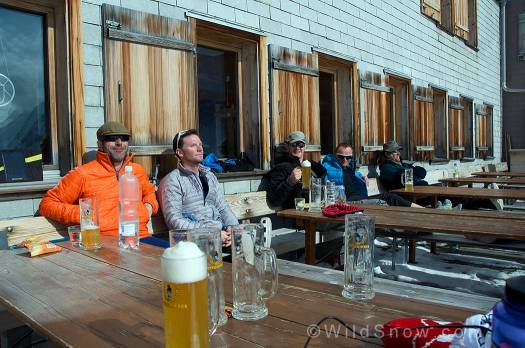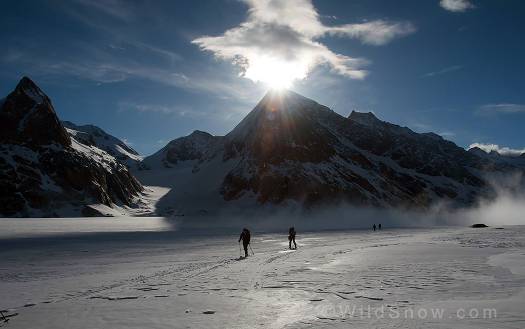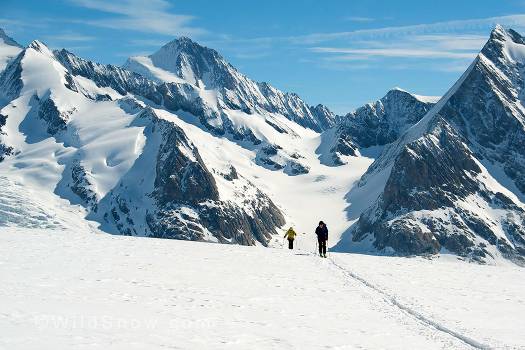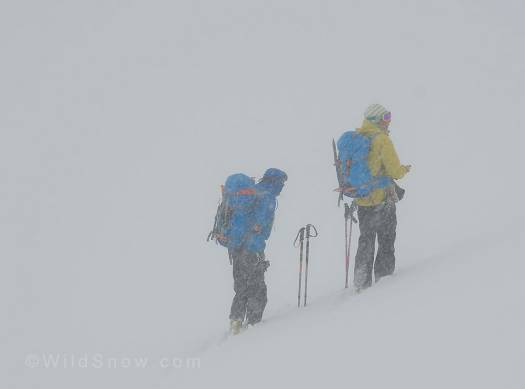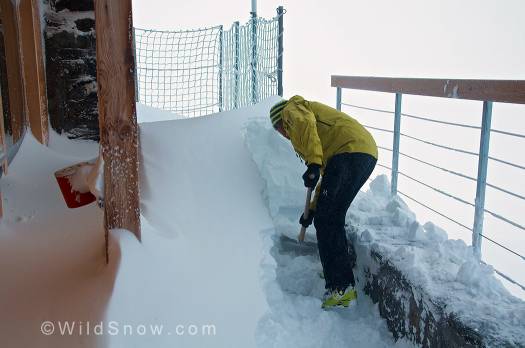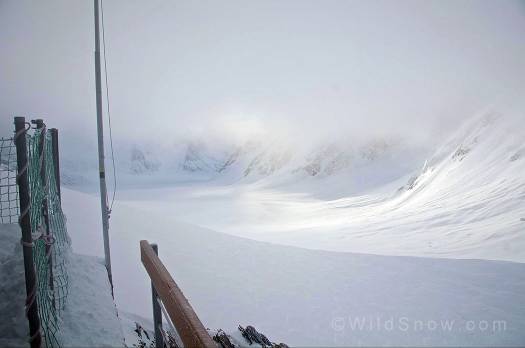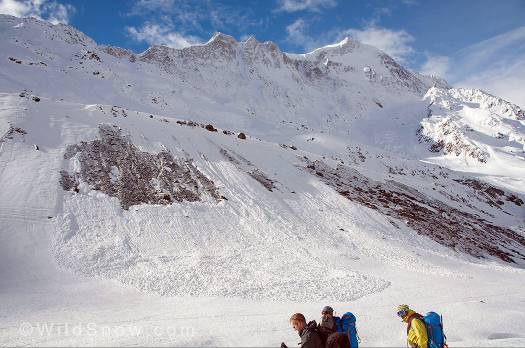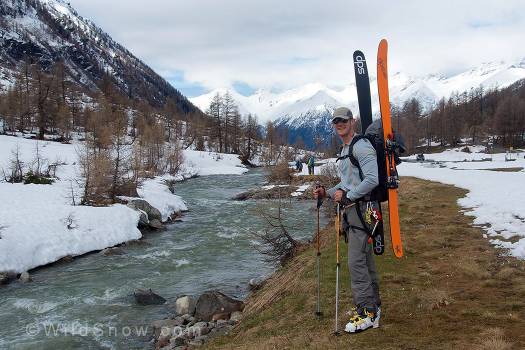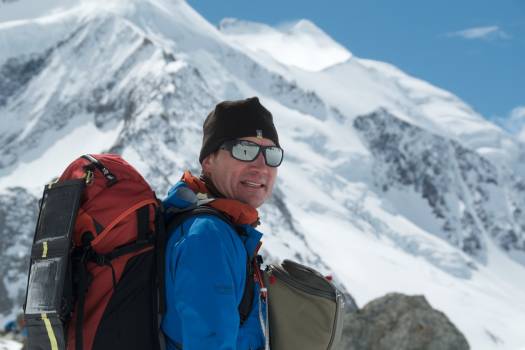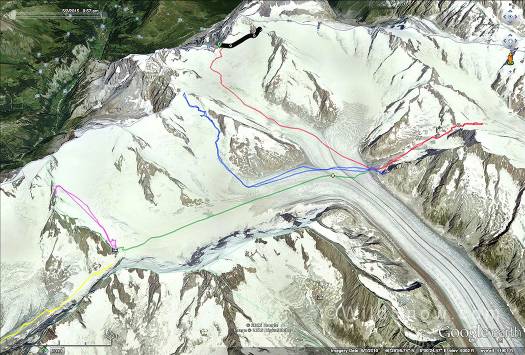Robert Suminsby
Is a high level of geekdom necessary for enjoying a few backcountry ski mountaineering turns? Obviously not. But let’s face it, some of us thrive on maps and data, especially if it’s an epic adventure like a tour in the Alps. If you’re that guy or gal, the Goal Zero Nomad 7 solar panel and Guide 10 power pack offer a pretty solid means of keeping your thirsty electronics happy and your inner geek satisfied, at a reasonable weight penalty. Here in part 2 of our saga, we look at some good and bad situations during a test outing in the Bernese Oberland.
Two days after we left Jungfraujoch (see Part 1 of our trip report here), we overnighted at Konkordia Hut. After a tasty breakfast we began the long trudge down steel steps to the glacier. The day’s itinerary took us west across the Konkordiaplatz, then north along the Kranzbergfirn towards a saddle known as Louroitor. Crevasses on the left of our route forced us to backtrack and hug the right side of the glacier, closer than we wanted to a debris field of icefall that we crossed as expeditiously as possible. Topping out at the pass, we could peer down on the Jungfraujoch and see a long line of tourists creeping along the top of the glacier like ants on a sugar bowl. The descent back to Konkordiaplatz offered more fine powder turns while soaking in the breathtaking scenery of the Bernese Oberland.
Back at the hut, I set up the Goal Zero to soak up afternoon photons, while we all ordered beers and set about doing exactly the same thing. I pulled out my iPhone and composed a couple of messages for the InReach, using Delorme’s Earthmate app. The app links to the InReach via Bluetooth, and allows you to check messages, review tracking data points, and provides a much more convenient means of entering the text of a message than the cursor-controlled keyboard on the device itself. (It’s a disappointment that social media posts can’t be entered via Earthmate. That requires you to use the much more laborious cursor entry method on the InReach itself.)
When the temps began to drop and we retreated inside, I was pleased to discover that the range of the Bluetooth allowed me to sit in the warmth of the hut and check messages with my phone using the Earthmate app, while staying connected to the InReach outside in the elements. I checked the track of the day’s travel captured by the InReach, but its accuracy is somewhat crude. Unless you have paid for the high-end “Expedition” service package, the shortest tracking interval is every 10 minutes. Not bad if someone is simply trying to locate you, but I was glad to have my Sunnto capturing data points every 10 seconds to have an accurate depiction of our ascent and descent.
On Thursday we made the long, gentle ascent of the Grosser Aletschfirn to Hollandia Hut under mostly clear skies, a western skintrack that put the morning sun squarely at my back. A perfect Goal Zero solar charging situation! I had selflessly offered up spare power to a few other folks in our group the night before, but by the time we reached the hut at midday, I was fully charged once again.
We dropped our excess gear at the hut and set out for a col just south of the Mittaghorn. After an exciting crossing of a narrow snow bridge over a deep crevasse, it turned into a fairly long slog to gain just a small bit of vertical, but the views of the surrounding glaciers and peaks made it worthwhile. Back at the hut, I topped off all my devices from the Guide 10, then pulled out the Nomad 7 panel and hung the apparatus from some steel cables that surrounded the outside deck. Yes, those hanging loops and mini-biners are pure genius. I oriented the panel west, but the gathering cloud cover didn’t suggest I’d get much of a top-off.
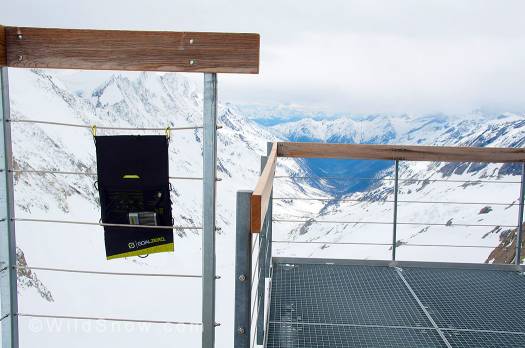
Solar prospects looking dubious. But the ‘biners and loops on the Goal Zero once again prove ingenious.
As evening settled, the weather closed in with a vengeance. Snow started to pile up on the deck outside, and the wind howled over the pass ferociously. Inside though, the atmosphere was convivial, the food excellent, and the wine flowed freely as we toasted what we thought would be the final night of our adventure.
Friday morning, the storm didn’t seem to have abated at all, and at least 18” of new snow had piled up outside the hut. Despite the visibility of no more than 50 meters, we packed our gear, donned our harnesses and packs, and headed out into the elements. One by one, we dropped down towards the col. We had descended only about 200 vertical feet when we came to a halt, and Stefano skied past me from the back of the line to confer with Gilles. They spent a good ten or fifteen minutes probing the snow, consulting the GPS and discussing options. One member of our group, who was on telemark gear, had not proven to be a very strong skier, and the guides were clearly worried that the combination of slow going in deep snow, limited visibility, and wet slab avalanche hazard made a descent too risky. They passed the word up the line that we wouldn’t be descending today. Not knowing whether to feel discouraged or relieved, I executed a kick turn, donned my skins, and headed back the way we’d come towards the hut.
Faced with an unplanned night in the mountains, we were nonetheless happy to be pinned down in a hut as pleasant at Hollandia, where the food is exceptional. As an added bonus the hut had a clear line of sight to cell towers in the villages far down the valley, as most of our party started frantically rebooking return flights. Cell phone batteries were fading, but I was able to spare some juice for those in need. The Guide 10 proved useful in another way as well: the guides were a bit concerned that the batteries on their GPS were running low, and although there was no sunshine to collect, the Guide 10 can charge AA batteries through it’s USB input, and happily Gilles had a standard charger with a Swiss plug and USB output, so we were able to mooch some power from the hut’s dwindling mains supply to charge the batteries and keep their GPS fully functional. A good thing, as the storm showed no signs of lifting. While power might have been running low, food and drink were still in ample supply.
We discussed our options. If the visibility lifted enough and the avalanche hazard seemed manageable, we could ski down towards the village of Kippel, call for a cab to the train station, and return to Grindelwald in just a few hours time. If a safe descent wasn’t possible, our only other option would be to ski back east to Konkordiaplatz, and then make the long skin back up the glacier to the Jungfraujoch to catch the train there. With the whole route blanketed in new snow, that promised to be a very long day indeed.
By Saturday the drifts outside the hut were three feet deep in places, but the sky seemed to suggest the possibility of clearing. We worked in shifts to shovel a clear path to our skis. The guides had decided that the member of our group who had struggled in the deep snow the day prior was not up to the descent, so they had telephoned for a helicopter to take him down. With that bit of news, we donned our skis and began packing down a landing pad for the helo, a task I certainly hadn’t anticipated. As we completed that chore, the cloud level lifted somewhat, and my heart leapt at the promise of a 3000’ descent in new snow.
Energized by that notion, we quickly dropped to the col and enjoyed fresh tracks in the creamy snowpack. Before long we were back in the soup, and sticking closely to the guides’ tracks as they pioneered a fresh path over the glacier, roped together for safety. Dropping below the cloud layer again, the snow soon turned heavy and wet, and looking up at the steep walls of the valley, we could see why the guides had been rightly concerned the day before: rain at the lower elevations had triggered huge wet slab avalanches, some of which had run-out zones well into the valley floor.
As so often happens on spring tours, eventually the snow ran out, but only when we were within sight of the parking lot where a taxi would meet us. Walking the last few hundred yards along a picturesque river was a fitting way to end our ski journey, and the taxi ride down the valley past waterfalls, chalets and lush green pasture made me promise myself I would return again soon.
Back home in New Mexico, I had great fun downloading the GPS tracks and importing them to GoogleEarth to generate an overlay of the entire trip. By now you’re either shaking your head and wondering why anyone would ever want to burdened with all these gadgets, or else you’re thinking, “Man, I need that!” If you’re in the latter camp, good news. With a little device management and favorable weather, a single Goal Zero setup should keep a party of several people fully charged with all the gadgets they might want in the backcountry. Just try not to get pinned down in a storm for too many consecutive days.
(WildSnow.com guest blogger Rob Suminsby is a retired U.S. Air Force officer who has been skiing for many decades. When Rob had to give up flying F-15s, he turned to off-piste skiing, and eventually ski touring, to get his thrills. He spent four years living in Germany and traveled over much of the Alps in search of untracked snow. He now resides in New Mexico and pillages powder in the Sangre de Cristo and San Juan mountains.)
Beyond our regular guest bloggers who have their own profiles, some of our one-timers end up being categorized under this generic profile. Once they do a few posts, we build a category. In any case, we sure appreciate ALL the WildSnow guest bloggers!

